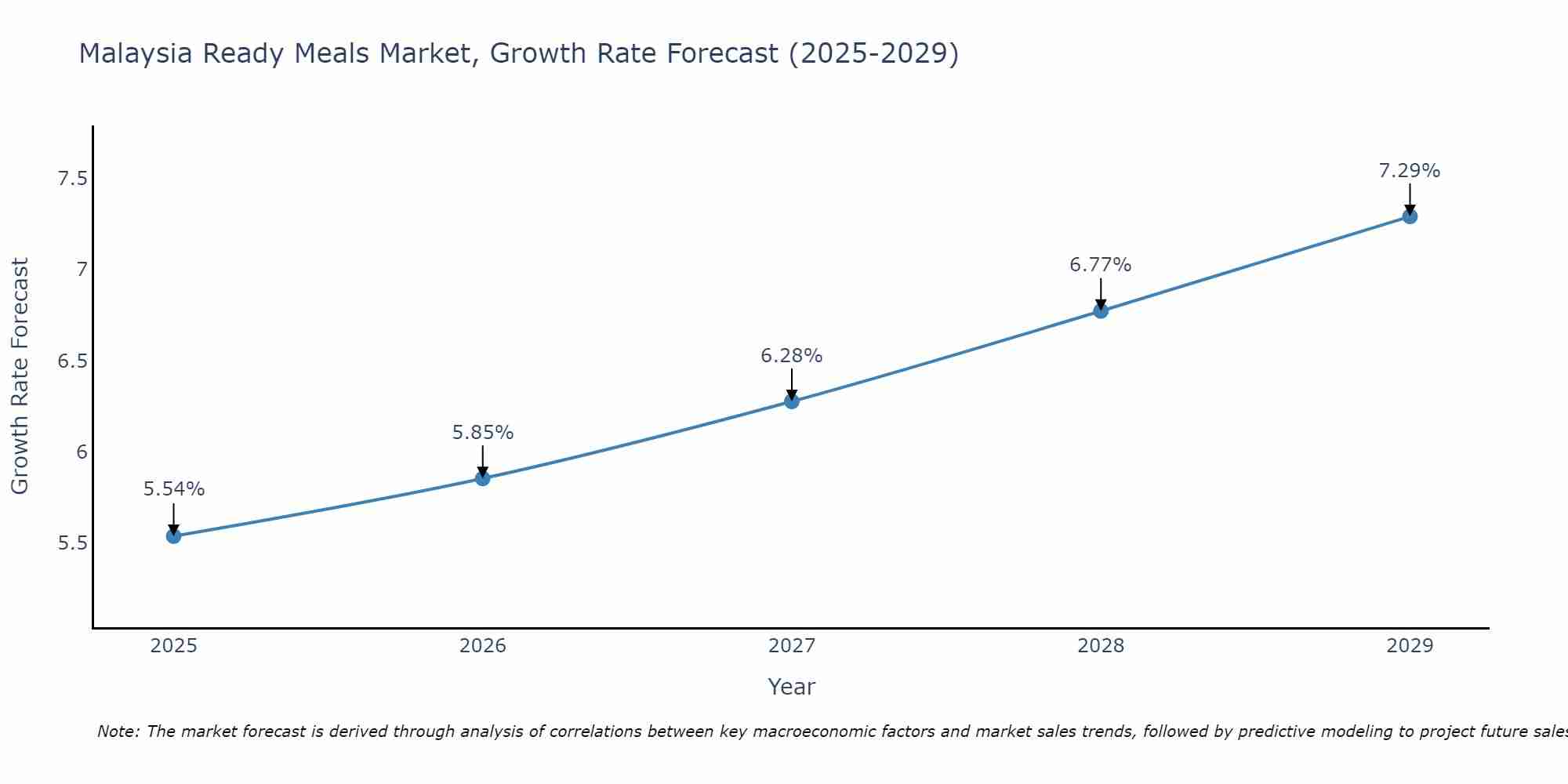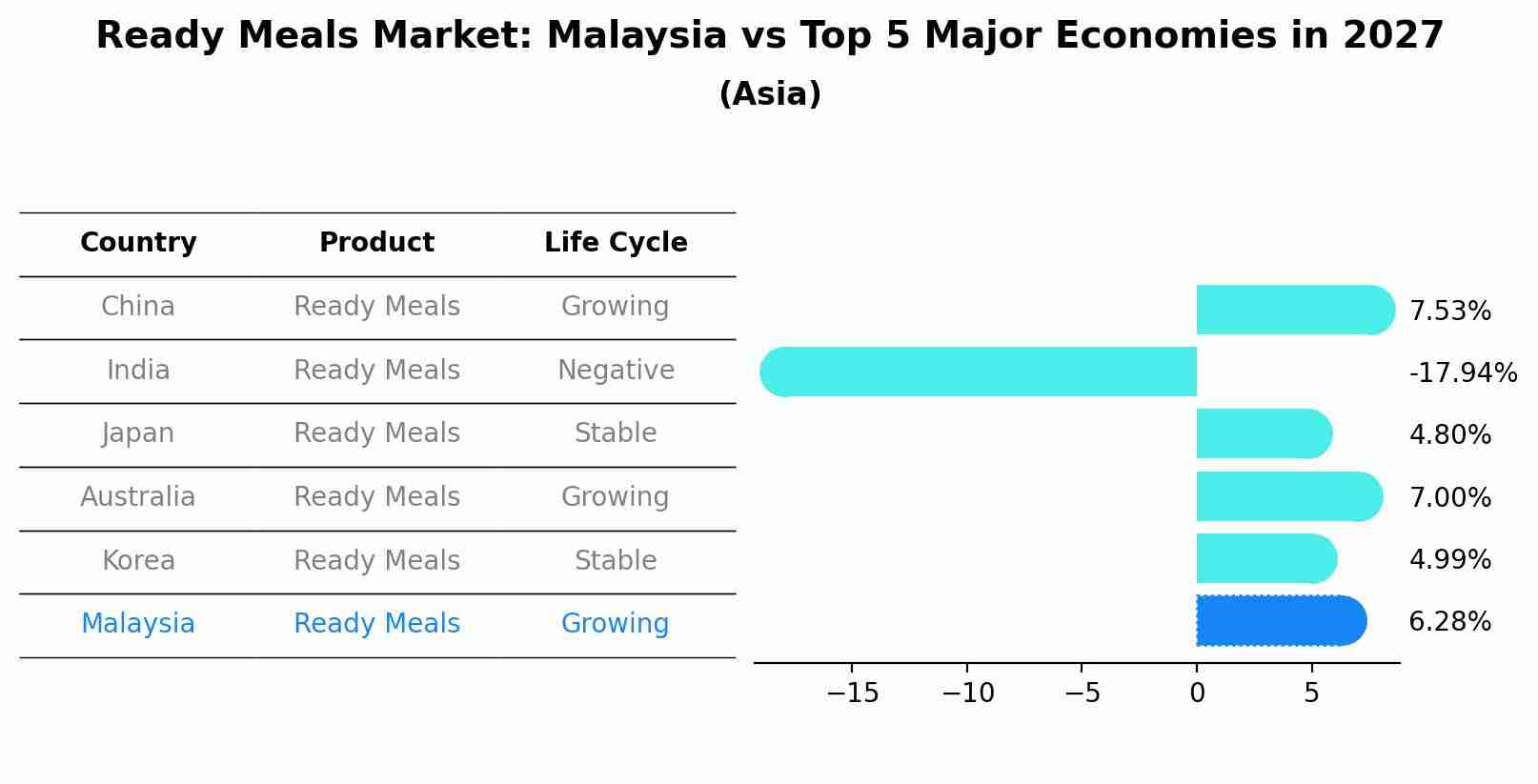Malaysia Ready Meals Market (2025-2031) Outlook | Industry, Trends, Revenue, Companies, Share, Value, Analysis, Forecast, Growth & Size
| Product Code: ETC428182 | Publication Date: Oct 2022 | Updated Date: Aug 2025 | Product Type: Market Research Report | |
| Publisher: 6Wresearch | Author: Ravi Bhandari | No. of Pages: 75 | No. of Figures: 35 | No. of Tables: 20 |
Malaysia Ready Meals Market Size Growth Rate
The Malaysia Ready Meals Market is poised for steady growth rate improvements from 2025 to 2029. Commencing at 5.54% in 2025, growth builds up to 7.29% by 2029.

Ready Meals Market: Malaysia vs Top 5 Major Economies in 2027 (Asia)
Malaysia's Ready Meals market is anticipated to experience a growing growth rate of 6.28% by 2027, reflecting trends observed in the largest economy China, followed by India, Japan, Australia and South Korea.

Malaysia Ready Meals Market Synopsis
The ready meals market in Malaysia is experiencing significant expansion, influenced by changing consumer lifestyles and preferences. Busy schedules and a rising appetite for convenience are driving the demand for ready-to-eat meals. Market players are expected to focus on diverse, healthy, and culturally diverse meal options to capture a larger market share.
Drivers of the Market
The Malaysia ready meals market is poised for substantial growth due to several key drivers. Firstly, changing consumer lifestyles and the increasing preference for convenience foods are propelling the demand for ready meals. Busy lifestyles and a rise in dual-income households are leading consumers to seek quick and hassle-free meal solutions. Additionally, the COVID-19 pandemic has accelerated the adoption of ready meals as consumers sought convenient and hygienic food options. Moreover, innovations in packaging and food processing technologies are enhancing the quality and shelf life of ready meals, further boosting market growth. The expanding retail landscape and the growth of online grocery shopping platforms are also expected to contribute to the market`s upward trajectory.
Challenges of the Market
The Malaysia ready meals market is poised for robust growth, fueled by changing consumer lifestyles and a preference for convenient food options. Market players should focus on product innovation, including healthier and culturally diverse offerings. However, ensuring product quality, compliance with food safety standards, and managing distribution networks will be pivotal challenges for industry stakeholders.
COVID-19 Impact on the Market
The ready meals market in Malaysia has witnessed significant changes in consumer behavior due to the COVID-19 pandemic. With restrictions on dining out and an increased focus on hygiene, the demand for packaged and ready-to-eat meals surged during lockdowns. Consumers sought convenient and safe meal options, leading to a boom in the ready meals market. This trend is expected to continue as consumers maintain a preference for home-cooked alternatives. To stay competitive, companies in the ready meals sector are investing in product innovation and expanding their online presence to cater to the growing demand for convenient meal solutions.
Key Players in the Market
The Malaysia ready meals market is experiencing significant growth, with key players leading the way. Established brands like Nestl?, Ayamas, and CP Foods offer a wide range of ready-to-eat meal options known for their convenience and taste. These companies have a strong presence in the market and cater to the evolving preferences of consumers. Local manufacturers, including Sedap Food, play a crucial role by offering a variety of local and traditional ready meals. As busy lifestyles and the desire for convenience drive the demand for ready meals in Malaysia, the market is expected to expand, providing opportunities for both global and local players to innovate and capture market share in this competitive landscape.
Key Highlights of the Report:
- Malaysia Ready Meals Market Outlook
- Market Size of Malaysia Ready Meals Market, 2024
- Forecast of Malaysia Ready Meals Market, 2031
- Historical Data and Forecast of Malaysia Ready Meals Revenues & Volume for the Period 2021-2031
- Malaysia Ready Meals Market Trend Evolution
- Malaysia Ready Meals Market Drivers and Challenges
- Malaysia Ready Meals Price Trends
- Malaysia Ready Meals Porter's Five Forces
- Malaysia Ready Meals Industry Life Cycle
- Historical Data and Forecast of Malaysia Ready Meals Market Revenues & Volume By Application for the Period 2021-2031
- Historical Data and Forecast of Malaysia Ready Meals Market Revenues & Volume By Restaurants for the Period 2021-2031
- Historical Data and Forecast of Malaysia Ready Meals Market Revenues & Volume By Hotels for the Period 2021-2031
- Historical Data and Forecast of Malaysia Ready Meals Market Revenues & Volume By Corporate for the Period 2021-2031
- Historical Data and Forecast of Malaysia Ready Meals Market Revenues & Volume By Household for the Period 2021-2031
- Historical Data and Forecast of Malaysia Ready Meals Market Revenues & Volume By Others for the Period 2021-2031
- Historical Data and Forecast of Malaysia Ready Meals Market Revenues & Volume By Distribution Channel for the Period 2021-2031
- Historical Data and Forecast of Malaysia Ready Meals Market Revenues & Volume By Online Stores for the Period 2021-2031
- Historical Data and Forecast of Malaysia Ready Meals Market Revenues & Volume By Offline Stores for the Period 2021-2031
- Malaysia Ready Meals Import Export Trade Statistics
- Market Opportunity Assessment By Application
- Market Opportunity Assessment By Distribution Channel
- Malaysia Ready Meals Top Companies Market Share
- Malaysia Ready Meals Competitive Benchmarking By Technical and Operational Parameters
- Malaysia Ready Meals Company Profiles
- Malaysia Ready Meals Key Strategic Recommendations
Frequently Asked Questions About the Market Study (FAQs):
1 Executive Summary |
2 Introduction |
2.1 Key Highlights of the Report |
2.2 Report Description |
2.3 Market Scope & Segmentation |
2.4 Research Methodology |
2.5 Assumptions |
3 Malaysia Ready Meals Market Overview |
3.1 Malaysia Country Macro Economic Indicators |
3.2 Malaysia Ready Meals Market Revenues & Volume, 2021 & 2031F |
3.3 Malaysia Ready Meals Market - Industry Life Cycle |
3.4 Malaysia Ready Meals Market - Porter's Five Forces |
3.5 Malaysia Ready Meals Market Revenues & Volume Share, By Application, 2021 & 2031F |
3.6 Malaysia Ready Meals Market Revenues & Volume Share, By Distribution Channel, 2021 & 2031F |
4 Malaysia Ready Meals Market Dynamics |
4.1 Impact Analysis |
4.2 Market Drivers |
4.2.1 Busy lifestyles leading to increased demand for convenient food options |
4.2.2 Growing urbanization and changing dietary habits |
4.2.3 Increasing number of working professionals and dual-income households |
4.3 Market Restraints |
4.3.1 Health concerns and rising awareness about the importance of fresh and healthy food |
4.3.2 Competition from traditional home-cooked meals and local street food vendors |
5 Malaysia Ready Meals Market Trends |
6 Malaysia Ready Meals Market, By Types |
6.1 Malaysia Ready Meals Market, By Application |
6.1.1 Overview and Analysis |
6.1.2 Malaysia Ready Meals Market Revenues & Volume, By Application, 2021-2031F |
6.1.3 Malaysia Ready Meals Market Revenues & Volume, By Restaurants, 2021-2031F |
6.1.4 Malaysia Ready Meals Market Revenues & Volume, By Hotels, 2021-2031F |
6.1.5 Malaysia Ready Meals Market Revenues & Volume, By Corporate, 2021-2031F |
6.1.6 Malaysia Ready Meals Market Revenues & Volume, By Household, 2021-2031F |
6.1.7 Malaysia Ready Meals Market Revenues & Volume, By Others, 2021-2031F |
6.2 Malaysia Ready Meals Market, By Distribution Channel |
6.2.1 Overview and Analysis |
6.2.2 Malaysia Ready Meals Market Revenues & Volume, By Online Stores, 2021-2031F |
6.2.3 Malaysia Ready Meals Market Revenues & Volume, By Offline Stores, 2021-2031F |
7 Malaysia Ready Meals Market Import-Export Trade Statistics |
7.1 Malaysia Ready Meals Market Export to Major Countries |
7.2 Malaysia Ready Meals Market Imports from Major Countries |
8 Malaysia Ready Meals Market Key Performance Indicators |
8.1 Consumer satisfaction levels with the taste and variety of ready meals |
8.2 Percentage of households using ready meals as a primary meal option |
8.3 Frequency of purchase of ready meals by target consumers. |
9 Malaysia Ready Meals Market - Opportunity Assessment |
9.1 Malaysia Ready Meals Market Opportunity Assessment, By Application, 2021 & 2031F |
9.2 Malaysia Ready Meals Market Opportunity Assessment, By Distribution Channel, 2021 & 2031F |
10 Malaysia Ready Meals Market - Competitive Landscape |
10.1 Malaysia Ready Meals Market Revenue Share, By Companies, 2024 |
10.2 Malaysia Ready Meals Market Competitive Benchmarking, By Operating and Technical Parameters |
11 Company Profiles |
12 Recommendations |
13 Disclaimer |
- Single User License$ 1,995
- Department License$ 2,400
- Site License$ 3,120
- Global License$ 3,795
Search
Thought Leadership and Analyst Meet
Our Clients
Related Reports
- Afghanistan Apparel Market (2026-2032) | Growth, Outlook, Industry, Segmentation, Forecast, Size, Companies, Trends, Value, Share, Analysis & Revenue
- Canada Oil and Gas Market (2026-2032) | Share, Segmentation, Value, Industry, Trends, Forecast, Analysis, Size & Revenue, Growth, Competitive Landscape, Outlook, Companies
- Germany Breakfast Food Market (2026-2032) | Industry, Share, Growth, Size, Companies, Value, Analysis, Revenue, Trends, Forecast & Outlook
- Australia Briquette Market (2025-2031) | Growth, Size, Revenue, Forecast, Analysis, Trends, Value, Share, Industry & Companies
- Vietnam System Integrator Market (2025-2031) | Size, Companies, Analysis, Industry, Value, Forecast, Growth, Trends, Revenue & Share
- ASEAN and Thailand Brain Health Supplements Market (2025-2031) | Strategy, Consumer Insights, Analysis, Investment Trends, Opportunities, Growth, Size, Share, Industry, Revenue, Segments, Value, Segmentation, Supply, Forecast, Restraints, Outlook, Competition, Drivers, Trends, Demand, Pricing Analysis, Competitive, Strategic Insights, Companies, Challenges
- ASEAN Bearings Market (2025-2031) | Strategy, Consumer Insights, Analysis, Investment Trends, Opportunities, Growth, Size, Share, Industry, Revenue, Segments, Value, Segmentation, Supply, Forecast, Restraints, Outlook, Competition, Drivers, Trends, Demand, Pricing Analysis, Competitive, Strategic Insights, Companies, Challenges
- Europe Flooring Market (2025-2031) | Outlook, Share, Industry, Trends, Forecast, Companies, Revenue, Size, Analysis, Growth & Value
- Saudi Arabia Manlift Market (2025-2031) | Outlook, Size, Growth, Trends, Companies, Industry, Revenue, Value, Share, Forecast & Analysis
- Uganda Excavator, Crane, and Wheel Loaders Market (2025-2031) | Strategy, Consumer Insights, Analysis, Investment Trends, Opportunities, Growth, Size, Share, Industry, Revenue, Segments, Value, Segmentation, Supply, Forecast, Restraints, Outlook, Competition, Drivers, Trends, Demand, Pricing Analysis, Competitive, Strategic Insights, Companies, Challenges
Industry Events and Analyst Meet
Whitepaper
- Middle East & Africa Commercial Security Market Click here to view more.
- Middle East & Africa Fire Safety Systems & Equipment Market Click here to view more.
- GCC Drone Market Click here to view more.
- Middle East Lighting Fixture Market Click here to view more.
- GCC Physical & Perimeter Security Market Click here to view more.
6WResearch In News
- Doha a strategic location for EV manufacturing hub: IPA Qatar
- Demand for luxury TVs surging in the GCC, says Samsung
- Empowering Growth: The Thriving Journey of Bangladesh’s Cable Industry
- Demand for luxury TVs surging in the GCC, says Samsung
- Video call with a traditional healer? Once unthinkable, it’s now common in South Africa
- Intelligent Buildings To Smooth GCC’s Path To Net Zero


















